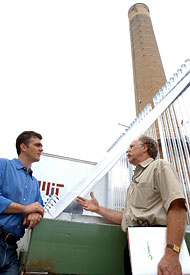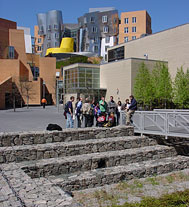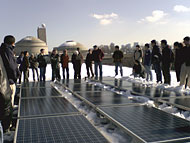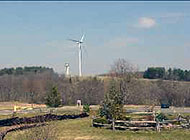Energy on Campus
Campus Emissions

Our campus greenhouse gas emissions are an important measure of MIT’s energy and environmental impact. An innovative analysis and inventory of our greenhouse gas emissions – originally conducted as an MIT graduate thesis - established a solid foundation on which to design and build a comprehensive mitigation program. The inventory, completed in 2003 and updated in 2005, allows for striking forecasts of future emissions and highlights the importance of taking action now to reduce greenhouse gases.
(Graphic: MIT Environmental Programs Office and Dept. of Facilities)
Combined Heat and Power Generation Technology
An effective component of a comprehensive greenhouse gas reduction strategy would be to expand the current combined heat and power (co-generation) capacity at the campus Central Utility Plant. Installing an additional 16 megawatt capacity with three natural gas-fired turbines could reduce annual greenhouse gas emissions by 53,000 equivalent metric tons of CO2, and save the institute upwards of $7 million a year in reduced energy costs. MIT’s award-winning 1995 installation of co-generation reduced MIT’s greenhouse gas emissions by 32%, and regulated pollutants NOx and SOx by 45%. Implementing and demonstrating the latest co-generation technology offers MIT an excellent opportunity to lead by example and engage MIT’s research community.
Solar Photovoltaic Power Systems
The MIT Community Solar Power Initiative has recently and successfully completed the installation of 25 advanced solar photovoltaic systems on campus and in the community. Supported by a grant from the Massachusetts Technology Collaborative, the project lead by the Department of Facilities and the Laboratory for Energy and the Environment worked with local home owners, institutional leaders, and a host of local solar engineers, entrepreneurs, and installers to add over 74 kilowatts of solar energy capacity to the area - generating enough electricity to light over 60 homes with no greenhouse gas emissions or other harmful emissions. The three systems on MIT’s campus (on buildings W20, N52, and 14) mark in important milestone: the first large-scale renewable power systems inter-connected to MIT’s power grid. The project has demonstrated MIT’s ability to bring new, innovative and renewable power to MIT’s campus: in a way that is practical, robust, and reliable. Additional renewable energy projects on campus will serve as important greenhouse gas mitigation opportunities as well as platforms for engaging our faculty and students for collaborative problem-solving.
Bio-Based Energy Innovation
MIT has recently been playing host to an innovative group of algae atop the roof of the Central Utility Plant. The algae, part of a beta installation of new bioreactor pollution control technology being developed by the energy start-up firm GreenFuel Technologies, is sequestering a fraction of the carbon dioxide being emitted from the power plant’s emission stream while also removing polluting nitrogen oxides. As the algae feeds on the CO2 and other pollutants, it grows in volume and gives off oxygen and nitrogen, producing biomass that can be converted into biofuels including biodiesel. MIT is currently considering expanding their collaboration with Greenfuel to process the algae on campus into biodiesel for possible use on campus in an innovative renewable fuel cycle. The installation at MIT has proven the new technology feasible and Greenfuel is currently in the process of building a large-scale industrial application.
Supporting the development of this type of innovative energy technology is a good example of MIT opening its operations as a learning laboratory to explore options for sustainable energy and emission control technologies.
Sustainable Design
Integrating innovative technologies and systems into new buildings and renovations is putting MIT on the forefront of sustainable building. MIT has developed Institute environmental goals and standards to make sure that new capital projects and renovations earn the Leadership in Energy and Environmental Design (LEED) Silver Plus certification, a nationally recognized building sustainability rating system. Two recent projects, the Stata Center and the Brain and Cognitive Sciences Building, are LEED registered and plans for certification are being developed. Among innovations, the Stata Center employs a creative storm water retention/management system that uses biofiltration, recirculating storm water with a solar powered pump for irrigation and flushing toilets. The building also extensively uses more efficient displacement ventilation utilizing a raised floor system. The Brain and Cognitive Sciences Building employs heat recovery methods incorporated into HVAC systems, and uses variable air volume systems and balanced sizing of HVAC equipment to reduce energy use.
The Campus as a Learning Laboratory
MIT’s operations - from its power generation systems, transportation fleets, recycling programs, and building initiatives to its organizational and management structures offer rich, real world opportunities to study and test new solutions for today’s most pressing energy and environment issue in real time. The number of students and researchers interested in using our campus as a living laboratory is growing rapidly, and programs and projects to facilitate this type of study and education are being put into place. For example, the Environmental Programs Office and the Education Program of the Laboratory for Energy and the Environment have jointly developed a Campus Sustainability UROP program to facilitate the educational involvement of MIT undergraduates in practical research questions of interest and concern to sustainability initiatives at MIT. Students gain hands-on experience with real-world problems, practical experience designing a work plan and meeting expectations of a specific client, and empowerment from tangible impact on their community. MIT operational units gain knowledge to support the adoption of more sustainable operational practices on campus and benefit from a more informed student body.
Emerging Renewable Energy Opportunities
The development of renewable energy sources to power campus operations is an essential component of any institution’s sustainable energy portfolio. Expanding capacity of clean renewable power can off-set greenhouse gas emissions from conventional power use, and offer rich opportunities to excite and engage faculty, students and staff alike. MIT will explore viable and practical options for developing innovative renewable power projects. For example, a collaboration of departments including Facilities; Environment, Health and Safety; Environmental Programs Office; Bates Laboratory; and the Lab for Energy and the Environment is currently assessing the preliminary feasibility of installing wind turbine power generation technology at the MIT Bates Laboratory in Middleton, MA. The study will analyze the potential wind resource, electrical demands and financial implications. The photo at left simulates a scale representation of a 1.5 megawatt wind turbine installation on the Middleton campus.







